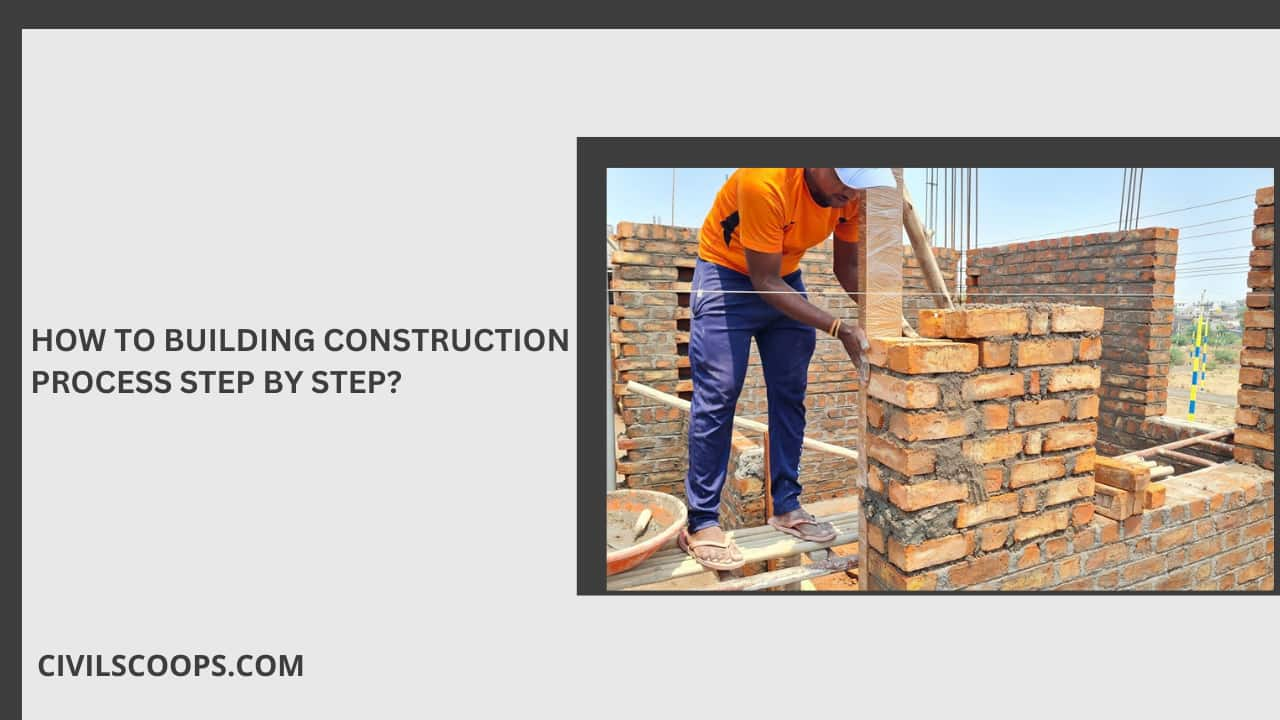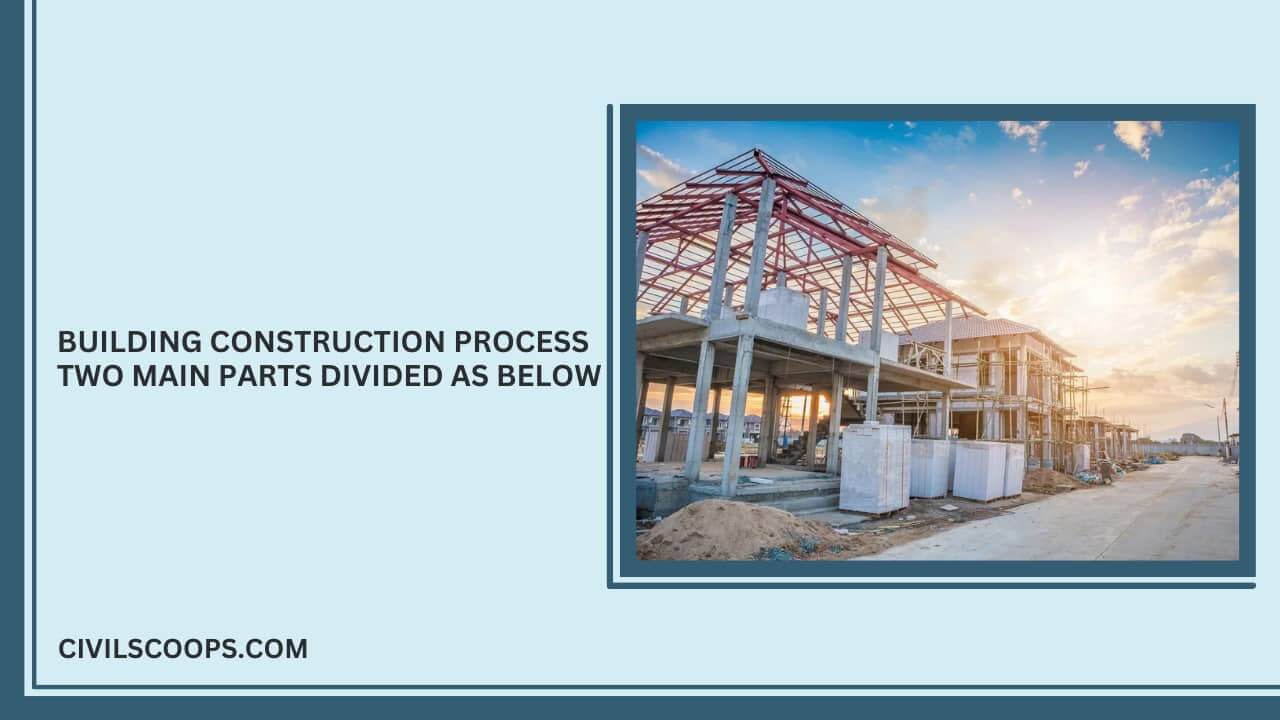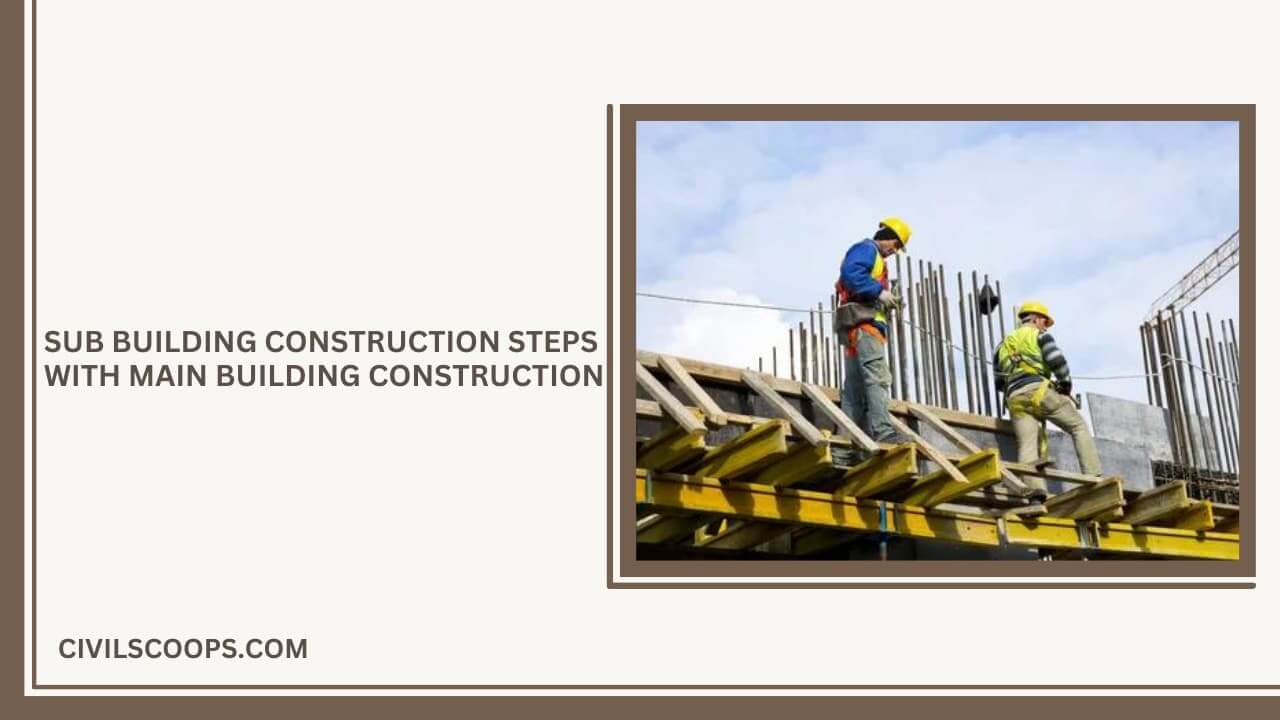
Table of Contents
How to Building Construction Process Step by Step?
As the decision of building construction is taken, the planning phase is started. The building construction process from start to finish is discussed here in detail. First of all start with some preconstruction steps.
The House construction Steps is explained in detail below:
Building Construction Process Two Main Parts Divided as Below

1. Pre-construction Steps:
- Acquire Land
- Seek Technical / Consultant
- Design Process
- Prepare Estimation and Budgets
- Building Permits
- Approach a Contractor
- Building Warranty Period
2. During Building Construction Steps:
- Site Clearance
- Excavation
- Foundation
- Plinth Beam or Slab
- Superstructure Column and Beam
- Brick Masonry Work
- Lintel Over Door Window
- Floor Slab or Roof Structure
- Plastering
- Door and Window Framing and Fixations
- Painting
- Electrical and Plumbing
- Exterior Finishing
- Internal Finishes
- Woodwork and Fixture Fittings
- Boundary Wall and Gates
- Hardscaping and Landscaping
- Punch List
- Warranty Period
The above main parts in sub-parts. These sub-parts related to his construction possess.
Building Construction Process from Start to Finish Pdf: Click Here
Sub Building Construction Steps with Main Building Construction

1. Pre-construction Steps
In this building construction process first step. This per construction possesses some points like plot hiring, planting, budget, consult hiring, contractor, Design process, etc.
a. Acquire Land

It is the main step in building construction. Search for the location for the building, which is most appropriate for building construction purposes. Be careful while selecting land that has all the desired facilities available nearby and should be free from all land-related issues.
It’s suggested that do prior data collection before buying land either by doing research online or seek help / Consultant from real estate agents or concerned persons regarding the effective cost of the same.
b. Seek Technical/Consultant

After selecting proper land for building, seek the help / constantan of a professional architect to create building designs, and take advice.
An architect prepare plan according to building requirement, a number of flats, shops based on your requirements also budget.
Then after architect consult with a structural engineer and MEP engineer for details of the reinforcements and other detail for use, how deep your foundation will be, the size of gravel to be used, column width, electrical, plumbing, etc.
c. Design Process

Before finding/meeting up with an architect, make a rough requirement list for your home. This process must cover the basic concepts of your home, like living space, no: of bedrooms you would like, Guest bedrooms, hall, kitchen, Baths, where you want the stairs, car porch, Garden/landscaping/Pond, etc.
You should involve your family also, ask their likes and suggestions. Visit your friends, talk to neighbors about the pros and cons of their property, and what they would like to improve. Stages of work in a glance.
d. Prepare Estimation and Budgets

Building construction involves a huge quantity of material and budget. After planning and structural detailing finished, these details are transferred into the building estimator.
The building estimation will estimate the material quantity, quantity of different items of works, and prepare an abstract sheet that shows the cost of building construction.
If financial resources are limited, we will need to seek pre-approval for loans in advance, or else you might end up in a cash crunch situation.
e. Building Permits

This is important work to do after the project is ready to be executed. For that, we must take permission from different boards before you can go for the construction, like this municipal, airport authority, pollution control, etc.
Following are the list of document project required before applying for permission. This document may differ from state to state, but a few are essential for every building construction work.
- Land Survey
- Soil test report (SBC report)
- All drawing like Plan, Elevation, Section
- Structural Certificate
- Architect Certificate
f. Approach a Contractor

A contractor for construction needs to be chosen carefully because it’s a major factor for securing building construction quality and timely construction of work.
Pre investigation has to be done about the builder before handing work. From the contract document, all of the work-related details must be clearly stated.
The contract document must cover layout and work details along with the cost payment methods and time scales. The condition of the contract ought to be thoroughly checked before signing a final deal.
g. Building Warranty Period
Once the project is complete and handover into the owner, the contractor specifies a warranty period.
In this period, any defects found in the building constructed have to be fixed and replaced with the contractor in charge.
The warranty for appliances and materials are obtained from manufacturers and supplier
2. During Building Construction Steps
In this building construction process first step. This per construction possesses some points like site clearance, Exaction, brick-masonry, plastering, as like different types of construction, etc.
More detail point as per below point
a. Site Clearance

Before starting any construction work, it becomes necessary to clear the place from the unwanted grass, Boulder, etc.
In case of any hill like appearance on the ground, that also has to be cleared of the excess earth, and when there’s a pit, it’s required to be filled up. This total job is known as site clearance.
b. Excavation

Following the site clearance, the layout of this structure in the site could be planned with respect to the given foundation plans. Begin earth excavation and take trenches accordingly.
c. Foundation

A foundation is the lower portion of building a structure that transfers its gravity loads into the earth. Foundation work is done based on drawings provided by the architect. I.e., the size of the foundation, depth, width, and length, etc. and kind of foundation (Rubble Packing or Raft and beams, etc. )
d. Plinth Beam or Slab
After the foundation work is completed, ground beam formwork preparation has been started and poured with concrete. Over the plinth beam, masonry work has been started. And space between foundation and plinth beam filled with soil.
Also, read: Density of Cement Sand and Aggregate | Density of Cement | Density of Sand | Density of Aggregate
e. Superstructure Column and Beam

The superstructure is the portion above the plinth level of the building. The main component of the superstructure is a beam and column. The columns are built up to the slab level, and the frame for further construction is prepared.
f. Brick Masonry Work

As beam and column framework completed, masonry work is started with various materials like fly ash bricks, concrete blocks, bricks, etc. according to building drawing.
Masonry work is done with a cement mortar mix. It’s a mixture of cement & sand. During this carefully and as per drawing, gaps are laid for windows and doors during the masonry work.
g. Lintel Over Door Window

The lintel is constructed on the Window and door to support the masonry work over it. After this, further masonry work is done.
h. Floor Slab or Roof Structure

Then the formwork is started to construct slab resting on the column and beam. Over slab formwork, slab reinforcement is put according to slab detailed drawing.
i. Plastering

Plastering work can commence after the initial lighting and electrical plumbing work was completed. Cement plaster is generally used with 12 mm thickness, and sometimes it may be of 20 mm thickness.
On completion of brickwork, plastering is to be done.
- To make the building structurally strong
- To protect it in the effect of weather, and
- To provide it an attractive look.
j. Door and Window Framing and Fixations

After that door and window frames have been fixed at their specified position given in drawing.
h. Painting

It is done with cement primer after initial wiring work, and plumbing works are done.
i. Electrical and Plumbing

As we know that buildings have been constructed with a clean finish in which electrical and plumbing work isn’t visible.
They’re installed in the walls and slabs such that they are concealed and not visible after the finishing work is done. The pipe and point end left out this later. They may be finished with the electric fitting and plumbing fixtures.
j. Exterior Finishing
After this work is completed, outside plastering and finishing work are started. Waterproofing can also be done to prevent rising dampness from the wall. External cladding may also be done to enhance the elevation of the house.
Also, read: What Is Steel | Types of Steel | How to Calculate Unit Weight of Steel Bars
k. Internal Finishes
Internal walls are plaster with a smooth finish, and flooring is done with tiles. Later on, the walls are stained or painted.
l. Woodwork and Fixture Fittings
By following the above step, almost construction work is completed and then after furniture work is started. Side by side, electrical fitting, switchboard, and plumbing fittings are complete in the kitchen and bathrooms areas too.
m. Boundary Wall and Gates

Compound walls must be built ideally just before beginning major construction activities. It’s to protect the site, and the material stored at the storage shed, in the outside environments, and from thieves. Latest gate designs.
n. Hardscaping and Landscaping

Once your builder has completed your home, there is still the”hardscaping” to be done – the driveway, patio and walkways, and then the”landscaping” plan could be put into action – the irrigation system, laying of grass bed and planting of trees, as well as outdoor lighting, to be considered.
Also, read: What Is Plaster | Plaster Ratio | History of Plastering | Requirements of Good Plaster
o. Punch List
When the project is complete, the contractor inspects the whole work one by one and make a punch list.
These structural units or areas that weren’t constructed properly or are below the quality level is listed in the punch list. This is later corrected by the contractor in charge.
p. Warranty Period
When the project is complete and handover into the owner, the contractor specifies a warranty period.
Within this period, any defects found in the building constructed have to be fixed and replaced with the contractor in charge. The warranty for appliances and materials are obtained from manufacturers and suppliers.
Video tutorial for better understanding:
Building Construction Process Step by Step Pdf in India: Click Here
Construction Process
The ‘construction process‘ (sometimes called the ‘construction stage’) is the physical processes of building, landscaping or refurbishing plus all the associated activities, such as demolition, site clearance, administration and so on. The following processes can form part of the construction process.
Pre-construction Steps
1. Testing quality of building materials
2. Site verification with reference to drawings
3. Sources of water and location of storage tank
4. Soil classification from trial pit
5. Mark the layout of main building
6. Material stacking plan
7. Verification of all the drawings and designs
8. Anti-termite treatment
During Building Construction Steps
Site Clearance, Excavation, Foundation, Plinth Beam or Slab, Superstructure Column and Beam, Brick Masonry Work, Lintel Over Door Window, Floor Slab or Roof Structure, Plastering, Door and Window Framing and Fixations, Painting, Electrical and Plumbing, Exterior Finishing, Internal Finishes, Woodwork and Fixture Fittings, Boundary Wall and Gates, Hardscaping and Landscaping, Punch List, Warranty Period
Process of Building Construction
- Prepare Construction Site and Pour Foundation.
- Complete Rough Framing.
- Complete Rough Plumbing, Electrical HVAC.
- Install Insulation.
- Complete Drywall and Interior Fixtures, Start Exterior Finishes.
- Finish Interior Trim, Install Exterior Walkways and Driveway.
What is the First step in Building Construction?
- The very first step of construction is make sure the ground is graded and prepared right.
- Next the foundation goes in. Depending on the type of building will determine the type of foundation is installed.
- Once the foundation is in then comes the framing. This is the skeleton of the structure.
- A contractor will then drywall the framing and install all the window and doors.
- Next come the electrical and the plumbing.
- While that is going on the roof may be finished up.
Building Construction Process from Start to Finish
- Pre-construction Steps
- Acquire Land
- Seek Technical/Consultant
- Design Process
- Prepare Estimation and Budgets
- Building Permits
- Approach a Contractor
- Building Warranty Period
- During Building Construction Steps
- Site Clearance
- Excavation
- Foundation
- Plinth Beam or Slab
- Superstructure Column and Beam
- Brick Masonry Work.
- Lintel Over Door Window.
- Floor Slab or Roof Structure
- Plastering
- Door and Window Framing and Fixations.
- Painting
- Electrical and Plumbing
- Exterior Finishing
- Internal Finishes
- Woodwork and Fixture Fittings
- Boundary Wall and Gates
- Hardscaping and Landscaping
- Punch List
- Warranty Period
House Construction Steps
- Site Preparation
- Floor Slab
- Framing – Walls & Roof Structure
- Roofing
- External Finishes
- Windows & Doors
- Rough Ins
- Internal Finishes
- Carpentry
- FF&E Fit Out
- Practical Completion
- Handover
What Is the First Step in Building Construction?
- The very first step of construction is make sure the ground is graded and prepared right.
- Next the foundation goes in. Depending on the type of building will determine the type of foundation is installed.
- Once the foundation is in then comes the framing. This is the skeleton of the structure.
- A contractor will then drywall the framing and install all the window and doors.
- Next come the electrical and the plumbing.
- While that is going on the roof may be finished up.
Building Construction Process from Start to Finish
- Site Clearance
- Excavation
- Foundation
- Plinth Beam or Slab
- Superstructure Column and Beam
- Brick Masonry Work.
- Lintel Over Door Window.
- Floor Slab or Roof Structure
- Plastering
- Door and Window Framing and Fixations.
- Painting
- Electrical and Plumbing
- Exterior Finishing
- Internal Finishes
- Woodwork and Fixture Fittings
- Boundary Wall and Gates
- Hardscaping and Landscaping
- Punch List
- Warranty Period
Step of Construction
- Creating a Concept and Design
- Obtaining Building Permits
- Clearing and Excavating the Land
- Pouring the Foundation
- Completing the Framing
- Doing Rough Electrical and Plumbing
- Installing the Roof
- Taking Care of Heating and Cooling Needs
- Completing the Interior
- Installing Fixtures
- Finishing Up
Building Processes
The building process comprises all processes throughout the life cycle of buildings and infrastructure; from strategic definition, programming, concept and detailed design, to construction, hand-over, operation and maintenance, and finally, disposal.
How Do You Build a House Yourself Step by Step?
- Prepare Construction Site and Pour Foundation
- Complete Rough Framing
- Complete Rough Plumbing, Electrical HVAC
- Install Insulation
- Complete Drywall and Interior Fixtures, Start Exterior Finishes
- Finish Interior Trim, Install Exterior Walkways and Driveway
- Install Hard Surface Flooring, Countertops; Complete Exterior Grading
- Finish Mechanical Trims; Install Bathroom Fixtures
- Install Mirrors, Shower Doors; Finish Flooring, Exterior Landscaping
- Final Walk-Through
What Is the Order of Construction?
The sequence of work to be followed in the construction of a building is the at most important procedures of construction. The major sequences of construction are marking, excavation, concreting, brick masonry, roof laying, flooring and finishing.
What Takes the Longest When Building a House?
Houses built by owners took the longest amount of time at 11. 4 months. Single-family homes built by hired contractors fell in the middle at 8.4 months from permitting to completion.
How to Build a Concrete House Step by Step?
1. Testing quality of building materials
2. Site verification with reference to drawings
3. Sources of water and location of storage tank
4. Soil classification from trial pit
5. Mark the layout of main building
6. Material stacking plan
7. Verification of all the drawings and designs
8. Anti-termite treatment
What Are the Steps in the Construction Process?
- Creating a Concept and Design
- Obtaining Building Permits
- Clearing and Excavating the Land
- Pouring the Foundation
- Completing the Framing
- Doing Rough Electrical and Plumbing
- Installing the Roof
- Taking Care of Heating and Cooling Needs
- Completing the Interior
- Installing Fixtures
- Finishing Up
Construction Process Steps
- Acquire Land
- Seek Technical/Consultant
- Design Process
- Prepare Estimation and Budgets
- Building Permits
- Approach a Contractor
- Building Warranty Period
Building Construction Process
- Acquire Land
- Seek Technical/Consultant
- Design Process
- Prepare Estimation and Budgets
- Building Permits
- Approach a Contractor
- Building Warranty Period
- Site Clearance
- Excavation
- Foundation
- Plinth Beam or Slab
- Superstructure Column and Beam
- Brick Masonry Work.
- Lintel Over Door Window.
- Floor Slab or Roof Structure
- Plastering
- Door and Window Framing and Fixations.
- Painting
- Electrical and Plumbing
- Exterior Finishing
- Internal Finishes
- Woodwork and Fixture Fittings
- Boundary Wall and Gates
- Hardscaping and Landscaping
- Punch List
- Warranty Period
Like this post? Share it with your friends!
Suggested Read –
- Building Layout | How to Building Layout | Construction Layout Techniques
- How a Building Is Constructed | Components of Building
- What Is Bituminous Road? | Bituminous Road Construction | Bituminous Road Layers | Bituminous Macadam | Bituminous Road Construction Process | Advantages of Bitumen Road | Disadvantages of Bitumen Road | Application Road
- What Is Super Elevation? | Superelevation Definition | Purpose of Providing Superelevation in Roads | Calculation of Superelevation in Roads | Minimum and Maximum Superelevation in Roads | Method of Providing Superelevation to the Roads
- What Is Lintel? | Function of Lintel | Types of Lintel